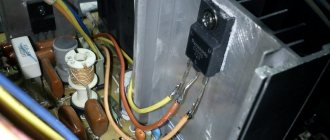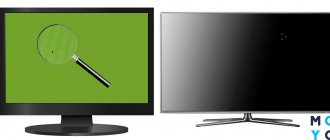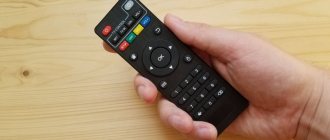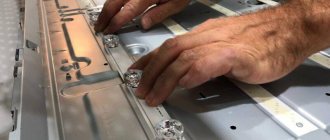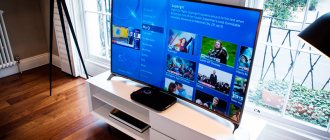When buying a new TV in a store, not many people know that they should check the TV for dead pixels. Manufacturers allow the presence of a certain number of inactive points on the matrix, not considering such a defect to be a manufacturing defect, therefore, having identified defects at home, it is unlikely that the panel will be returned under warranty.
To avoid disappointment with your purchase, checking for dead pixels should be carried out in the store. Often sellers offer this service for a fee, but if you first figure out how to check the TV for dead pixels, you can do it yourself, and if a defect is detected, demand another copy or refuse to purchase the selected model.
Pixel, what is it?
Today, liquid crystal displays are not something unusual or extraordinary. On the contrary, in addition to televisions, they are present in many devices: computer monitors, phones, cameras, navigators and other similar equipment. The basis of LCD or LCD technology is liquid crystals. After light from lamps or LEDs passes through a layer of crystals, a corresponding picture appears on the screen.
The matrix of a color TV is a huge number of tiny indivisible rectangular or round cells called pixels. In turn, each such object consists of red, green and blue subpixels. It is these colors, or rather their combinations, that are considered the basis of color television. The simultaneous lighting of all pixels forms a complete image on the screen. Moreover, the more pixels, the clearer the picture. If you look closely at the display, you can easily see the three colored areas of these objects.
Manual setup of Smart TV
Note! Set-top boxes from different manufacturers usually have their own ways of managing applications. Therefore, setting methods may vary slightly.
Before setting up Smart TV, you need to prepare a device to control the set-top box - this can be either a remote control, a mouse or a keyboard. Often, during the first boot of a smart set-top box, an installation wizard is displayed on the TV screen, which guides users through all the necessary setup steps. For example, in the process of setting up the Mi Box S smart box, in the first step the user can select a language, specify the home Wi-Fi network, if available, allow access to geodata, and so on. In addition, many set-top boxes allow users to sign into personal Google accounts in order to have access to a wider list of applications and services in the future.
At the first stage of setting up a smart set-top box, you must specify all the settings offered by the program. In addition, it is recommended to enter the exact date and time in the corresponding line of the settings menu. It is necessary to set the switch specifically for network time, otherwise most programs may not work correctly.
Then you need to check for updates in the tab called “About device” under the “System update” line. If there is no such section, it is recommended to look for updates in similar sections. In case there are new updates available, you need to download them. This is done to ensure that all the latest applications and options are available to the user.
Setting other parameters depends on the capabilities of the smart set-top box and the user’s desires. So, for example, if desired, he can change the screen resolution, sound, put a screen image, configure video playback methods, and so on. However, during the first time of use, as a rule, only standard settings are needed.
The concept of dead pixels, the reasons for their appearance
The number of pixels on the display is so huge that it is almost impossible to guarantee their 100% serviceability. Often on the screen you can see dots glowing in one color, completely motionless, which even with a change in the TV image do not change color or location. It is these objects that are commonly called dead pixels. They can be black, white and colored. There are two reasons for the occurrence of these defects: imperfect technology and ordinary manufacturing defects.
Dead pixels occur in two layers: liquid crystals and thin-film transistors.
After the transistor that controls the liquid crystals fails, black (“dead”) dots appear, indicating non-functioning cells. Subsequent management of these crystals is simply impossible. Such defects are most visible on a light background. Some experts consider it impossible to “treat” them, others argue that using a laser it is possible to partially return the pixel to its working condition.
The second reason is the subpixel frozen in one position. This problem appears in the liquid crystal layer. Such a “stuck” object appears on the display as a white (burning) or colored dot. To eliminate this defect, you can use special programs or carry out a series of physical manipulations. There are cases when dead pixels, after some time, disappear on their own.
Thus, when choosing an LCD TV, it is not enough to pay attention to its appearance, the presence of numerous functions, ports, and connectors. It is also important to check the device for matrix defects. Let's try to figure out how to check a TV before buying and protect yourself from purchasing low-quality equipment.
Monteon testing a computer display
Main page of the Monteon service
It is recommended to do tests indoors without sunlight and with minimal lighting for better perception of events on the monitor. The service will offer you full-screen mode, go to nago. To make the test management menu appear at the bottom of the screen, move the mouse. The tests menu allows you to scroll through unnecessary tests, flip slides (if the test allows it), turn off full screen mode, and return to the home screen. Along the edges of the monitor are arrows for moving from one test to another. You can replace the arrows used by the mouse with keyboard arrows. Their actions are equivalent. Also, for the test, it is recommended to disable all programs that correct color rendering on the display. They could be drivers for the video card. Go to the settings of this program and deactivate it for the duration of the test.
The following tests are available on the Monteon service:
- “16:9 format” is a special test conducted for monitors with the appropriate aspect ratio. When you run this test, you should see all the geometric shapes shown in the screenshot.
The figures must be of the correct shape, without any distortion. If there are deviations from the norm, then your monitor has problems.
- Zone Brightness is a great test to check the overall brightness and clarity of your monitor. The center circles in this test must be perfect and ugly. Further, with reduction, they should become less smooth and more clear. Circles may appear along the edges, similar to the central ones. All circles should not be oval, if this is the case, then there are problems with the display.
- “Contrast, brightness” - when performing this test, you should see separate boundaries of the figures. If there is merging of colors in some parts, then this is a sign that the monitor is not working properly. On high-quality monitors, equal degrees of brightness can be seen at various levels of the presented geometric shapes and in all colors.
- “Color rendition” is a test for testing the settings of the main shades and colors of the monitor. In modern LCD monitors, such problems practically do not arise. The test is usually used to check whether the color is displayed correctly. If color filtering programs are installed, you can use them to check the color reproduction of the monitor.
- “Dead pixels” - many modern monitors use the RGB color model (Red - red, Green - green, Blue - blue). Each elementary point (pixel) has three channels. When these three colors are mixed, colors with the same intensity are obtained. Color rendering tests involve single-color screens using a pattern. They use only one color channel - each color separately.
Only some of the tests that are available to users on this service are described. To view the full list of tests, go to the website and open the “Learn more about tests” section.
Allowable number of dead pixels
You can often see a picture in stores when a buyer tries to return a newly purchased TV after discovering defects on the screen, in particular, dead pixels. For the sake of truth, we note that usually a dispute between a store and a buyer ends not in favor of the latter. To avoid getting into an unpleasant situation, we recommend choosing a TV very responsibly. In particular, it is worth knowing how to check an LCD TV at a retail outlet when purchasing for dead pixels, and become familiar with certain standards, according to which displays are divided into four classes.
| Class | Constantly lit (white) pixels | Constantly off (black) dots | Defective subpixels (color) |
| per million pixels | |||
| I | 0 | 0 | 0 |
| II | 2 | 2 | 5 |
| III | 5 | 15 | 50 |
| IV | 50 | 150 | 500 |
Warranty case
Why is a certain number of dead pixels allowed? The fact is that the technology for producing LCD display matrices is very complex, and not even every device manufacturer can afford their own production. And such a defect can only be detected on an assembled device. If the manufacturer writes off screens even with minor defects as defective, the price of TVs and monitors will increase several times. Therefore, the following compromise was found:
- Manufacturers leave production at the same level and do not increase prices.
- Buyers assume the presence of a certain number of dead pixels, which is not a warranty case. However, the buyer has the right to check the display before purchasing.
How to check a TV in a retail chain
The information in the table indicates that first class products are completely free of dead pixels. The cost of a product depends on its class.
The picture is formed on the screen by all pixels of the display. For example, Full HD resolution (1920 x 1080) involves more than two million pixels. Knowing the acceptable standards for dead pixels and methods of checking for such defects, it is not difficult to choose high-quality equipment.
Testing of devices can also be carried out using special programs by connecting the TV to a computer or laptop. Often the buyer does not have a computer at hand, so it is extremely difficult to carry out such manipulations in the store. Now many stores offer a paid service for checking screens for defects. What to do in this case, should you agree or should you still try to cope with this work on your own?
The easiest way is to visually inspect the screen at close range for the presence of a dot glowing in a different color. An ordinary magnifying glass will be a reliable assistant in this check. Detection of black dots is possible when a white field is applied to the screen. To find white spots, just make the screen dark. Finding defective color subpixels can be made easier by changing the screen color one by one.
It is important to remember that some defects do not appear immediately, but only after the matrix is heated. Pictures in the form of colored stripes, grids, and checkerboard fills will also help you quickly find malfunctioning subpixels that stand out from the general background.
If you are planning to purchase new equipment, first of all, study the relevant information, in particular, how to check the TV when purchasing it in a store. To carry out testing, you need to select special images and videos. They contain special pictures of different colors that appear alternately on the screen. Then write this information onto a flash drive, and then go get the TV. Videos are usually accompanied by music, which allows you to simultaneously check the quality of the acoustics.
Many today prefer new generation devices with Ultra HD resolution (3840 x 2160). They are characterized by excellent color saturation, perfect transition from one shade to another, the ability to adapt any format to 4K, excellent sound, and many additional functions. To check a 4k TV when purchasing, you need to use pictures with the appropriate resolution.
Wired LAN connection to the Internet
The presented method of connecting Smart TV to the network is considered one of the simplest. Moreover, thanks to this method you can save a lot of money, because you don’t need to purchase additional equipment.
Connecting to the local network in this case occurs as follows:
- To begin with, it is worth noting that twisted pair cables are usually used to connect to an external modem. In this regard, you will need to have a crimping tool - with its help you will need to crimp the twisted pair wires. This can also be done using a very ordinary screwdriver. However, it's a little more difficult;
- You need to connect the Internet cable to the splitter. It is not at all necessary to use a splitter if in the future the Internet will be used only for the TV. In this case, the cable must be connected directly to the Internet port in the device;
- The Smart TV system then automatically initiates the process of configuring the network settings on the TV.
Is it possible to “cure” dead pixels?
Often, defects on the display appear during operation. Black dots, as mentioned earlier, cannot be removed on your own. As for colored pixels, there are two ways to get rid of them: physical treatment and hardware massage.
The first method involves using a regular cotton swab to massage the damaged area where the “stuck” pixel is located. Such manipulations are carried out in a circular motion with the device turned off. This method cannot be called completely safe, because careless movement not only will not save you, on the contrary, it may add to trouble.
The second method is to use special programs that are easy to find on the Internet. BadCrystal – does not always cope with the task, however, it’s worth a try. Practice shows that it removes stuck spots within a few minutes or a couple of days. The JScreenFix program is no less popular today. She not only finds the defect, but also eliminates it. Operating time from 20 minutes to 10 hours.
Thus, armed with the necessary test kit, you can safely head to the store for a new TV. Rush when checking the device is unacceptable. The test should be completed slowly, examining each section of the screen step by step.
Disadvantages of paid verification
If verification is so important and allows you to avoid complications, why don’t buyers order it all the time? It's about the negative aspects:
- Money spendings. They charge an average of 500 to 2000 rubles for the service. It is not paid everywhere, but recently more and more stores are inclined to pay for testing.
- Poor quality check. The employee's goal is to sell the product. The more sales he has, the higher his wages. It is logical that he will try to hide minor flaws from the buyer in order to improve his statistics. For example, an employee may not include all colors. A person who knows nothing about pixels will not even notice that the service is performed poorly. And in the end, after unpacking and installation, you will discover that somewhere there is a contrast point.
- Ability to perform testing yourself. Why pay for something you can do yourself? The pixel check takes 1-2 minutes and consists of displaying images of basic colors on the screen. Any person who knows how to handle a flash drive can handle this.
- Returns are not guaranteed. Many buyers forget that they can return equipment not only using a warranty card. There is a law that allows you to return goods to the store within 14 days from the date of purchase. The only requirement is that the device maintains its serviceability and presentation. The buyer is not even obliged to explain why he decided to refuse the goods; this is his legal right. So if you find a dead pixel on your screen, you should simply take it back to the store and get a refund in accordance with the relevant law. What's the point of a paid check then, other than saving time?
